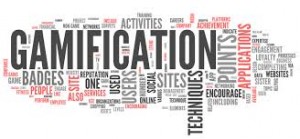Gamers are known to be particularly motivated people who practice self-discipline, learn well on their own, and find endless reserves of motivation, even when it involves repetitive tasks. It’s a natural extension to watch gamers and think, ‘How can we leverage what is great about games in order to encourage people to do necessary or desirable things?’ Clearly not everything can be turned into a game, but why not pick specific elements that we know and love in games and apply them to other tasks or applications?

In the last several years, the idea of gamification has begun to compel business people, marketers and change agents who work outside the game industry. The term was first coined in 2002, but it wasn’t until 2010 that it began to be used on a wider basis. The basic idea is that there are elements of game-play that can be used to motivate and reward behavior in just about any setting. Remember those gold stars you got as a kid for tasks or chores well done? That’s a type of gamification, particularly when the stars can be traded in for some desirable item.
Typically gamification applies to non-game applications and processes, in order to encourage people to adopt them, or to influence how they are used. Gamification works by making technology more engaging, by encouraging users to engage in desired behaviors, by showing a path to mastery and autonomy, by helping to solve problems and not being a distraction, and by taking advantage of humans’ psychological predisposition to engage in gaming. The technique can encourage people to perform chores that they ordinarily consider boring, such as completing surveys, shopping, filling out tax forms, or reading web sites. (Mashable)
It’s a bit of a controversial topic, because some observers think that adding video game elements is surely a fad. But with hordes of digital natives accustomed to gaming in the world, these approaches are certainly worth exploring. In fact, in a 2011 study conducted by MTV, it emerged that most digital natives report that a ‘game-like metaphor’ applies to just about everything in their lives.
Gamification techniques strive to leverage people’s natural desires for competition, achievement, status, self-expression, altruism, and closure. (Wikipedia)
To learn more about how video games motivate and engage, check out this TED talk from Tom Chatfield:
Why Gamification Works
If you know anything about human psychology, you’ll know that humans are hard wired to respond to reward. Pavlov’s dog is the classic example: ring a dinner bell before feeding the dog and the dog begins to salivate in anticipation each time they hear the bell. This is referred to as ‘extrinsic’ motivation.
Everything from market research to customer support are now being gamified, as business struggle to find new mechanisms to engage customers. There are also many options available for increased productivity in life, or to manage health care concerns. Social sites like Facebook and Quora also include gamification elements, like upvotes and ‘likes’. There aren’t tangible rewards associated with these mechanisms, but they go a long way towards making people feel recognized for their contributions.
Over 70% of Forbes Global 2000 companies surveyed in 2013 said they planned to use gamification for the purposes of marketing and customer retention. (Wikipedia)
Elements of Gamification
According to gamification consultancy Bunchball, there are several key components to gamification:
- Real-time Feedback reinforces useful behaviors by letting users see their progress as they go.
- Transparency allows users to see how their efforts stack up against others.
- Goal Setting gives focus to all interactions and can be used to reward behavior.
- Competition acts as a motivator to improve.
- Badges illustrate a user’s progress and allow them to show others their mastery.
- Leveling Up gives the user opportunities to progress and developers can reward them with more freedom and options.
- Teams allow users to combine their efforts with other users.
- OnBoarding and Mastery allow players to learn as they go, no manuals needed.
How to Gamify
The first step towards successfully gamifying anything is to put on your game designer’s hat and think about how to turn your site or service into an activity to be gamed.
- Understand what behaviors you want to encourage. This could be anything, from sharing an article to uploading a photograph or adding new friends or members to a service.
- Think about what might make the task or application more fun.
- Consider what kinds of gamification elements are most appropriate for your goals. It’s easy to start with something simple like badges, then progress to more complicated mechanics. Contests and sweepstakes are great motivators, and entries can result from certain activities or by accumulating points for a variety of act
- Decide what types of rewards you will offer. If someone accumulates a lot of points, for example, what do they receive in return?
- How will players redeem their rewards?
What do you think about gamification? Is it a useful step towards helping people be more productive?

